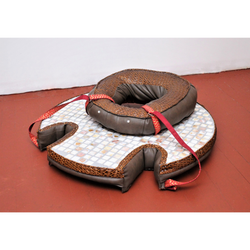
CURATOR STATEMENT
In Leonora Carrington’s memoir Down Below, the British Surrealist painter discovers a mysterious affinity with animals like goats, horses, and birds. They serve as metaphors for her state of mind. Her psychiatrist, for instance, plots to turn the “tigress” that Carrington is back into a “young lady.” Animals also appear in her visions. During a bout of shock therapy she endures in Spain in her twenties, she sees herself as a white colt tumbling down a hill. It’s no surprise that fauna and flora feature heavily in the work of the Surrealist movement (1924-1966), which Carrington survived by almost half a century. The Surrealists viewed the natural world as a place of myth and mysticism. Today, our relationship with the environment has changed as we’ve become increasingly aware of the symbiotic interconnectedness of all species, the fantasies we’ve projected onto land and resources, and the dire consequences of our extractions and emissions.
A Ball Court, Crocodiles is centered on the theme of eco-surrealism, which arose organically from the submission pool. Time and time again, I encountered dreamlike imagery, uncanny assemblages, and an ecologically attuned approach to materials. This coincides with the resurgence of surrealism in the artworld, most prominently in the curatorial direction of the 2022 Venice Biennale, suggesting that climate anxieties have manifested in both conscious action and subconscious turmoil across the art ecosystem.
Kathryn Freeman’s Living With Goats (2022) was the first submission to sink its teeth into my imagination. This oil painting, reminiscent of Carrington’s Self-Portrait (Inn of the Dawn Horse) (1937-38), shows a checker-tiled room with a large mirror and tall windows that open onto verdant fields and a band of blue mountains. A woman reading on a chaise-longue is surrounded by animals: four goats, a dog, and a flying goose that, strangely enough, casts no reflection in the mirror.
Thereafter, I was drawn to artists who make figures of shelter and architecture without inscribing divisions between human habitats and wilderness, who take interest in transitional spaces like plazas, porches, and game courts. Moreover, I sought works that defy the conventional separation of sealed, sterilized “art” spaces and “natural” spaces susceptible to weather and chance. I was touched, for example, by the work of artist Jay Lee, whose installation Home, Origin New Home (2023) features sheets of canvas strung across an airy patio, and Cristina Salas’ Dancing Muñeca (2023), a piece of land art composed of forty feet of seed-filled burlap sacks arranged in the shape of a doll, which grows and dissolves into the earth.
Ecological forms and processes take the stage in works by CV Peterson, who creates wall reliefs out of mycelia, Harvey Bayliss, who paints knotty nightscapes of the Florida swamp, and Sarah Knight, who sculpts with queer and ever-fluctuating geological matter. The conscientious act of salvaging such materials as cardboard (Rebecca Youssef) and shredded rice paper (Nicole Lau) lends a sense of transience and urgency to works in which domestic paraphernalia are the protagonists. These include Kiki Zhen’s toilet-shaped soft sculpture, which invites figures of waste and biological cyclicality into a sanitized art context, and Benedicta Opoku-Mensah’s assemblage of aluminum ladles and macramé cords, fittingly titled Hope for survival (2022). Prospects of displacement and transformation—entangled with feelings of fear and hope—are registered in Erica Bryant’s aqueous photocollage The Leader (2021), in which faces of human infants are superimposed on crocodile bodies, and Lucy Wood’s graphite drawing A ball court, crocodiles, billboard and bench (2023), from which this exhibition derives its title. Here, a human-constructed space for games—a beloved motif of the twentieth-century Surrealists—has been abandoned and reoccupied by a congregation of reptiles, reminiscent of the animals that roamed the streets in 2020 when humans retreated into lockdown.
The crocodile is also a motif associated with Carrington, in whose painting How Doth the Little Crocodile (1998), a family of reptiles rowing a boat in their likeness appears to be journeying far from home. In the end, a show that’s overtly about ecological concerns and surrealist tactics cannot help but betray a subconscious preoccupation with the subject of home. The mood of all these works is uncanny, or unheimlich, unhomely.
When considering how we’ve made our planet unhomely for nonhumans and humans alike, two readings of the term “eco-surrealism” present themselves like a forking path. On the first path, the natural world descends into a bizarre state we no longer recognize as reality—recall, for instance, the summer of 2023 when Canadian wildfires painted the skies of New York orange. The second path is guided by surrealism in a positive sense and leads to alternate realities in which ossified chains of belief are broken. While it looks as though our planetary habitats are collapsing before our helpless eyes, artists today are inviting us onto the second path, where we can envision ourselves as the ones who unmake—and remake—our mode of being at home in the world.
Jenny Wu

FEATURED ARTISTS
Vibeke Andersen
Harvey Bayliss
Erica Bryant
Monica Church
Kathryn Freeman
Ellen Gallup
Anshu Garg
Lolo Gem
Dariusz Kaca
Sarah Knight
Nicole Lau
Jay Lee
Ji Eun Lim
Jason Lord
Daohua Lou
Cristina Marian
Benedicta Opoku-Mensah
Sung Eun Park
Katy Paull
CV Peterson
Joanna Poag
Harrison Rios
Mary Robinson
Cristina Salas
Charlotte Schmid-Maybach
Michael Webster
Lucy Ray
Hikaru Yayoi
Rebecca Youssef
Kiki Zhen
A BALL COURT, CROCODILES
 Kiki Zhen |  Daohua Lou |  Rebecca Youssef |
|---|---|---|
 Lolo Gem |  Nicole Lau |  Benedicta Opoku-Mensah |
